| Author | Message | ||
| Ben Millermon (Brainsboy)
Member Username: Brainsboy Post Number: 271 Registered: 5-2001 |
put the #3cly plug and wire on cly 4, and cly4 plug and wire on #3cly. Then drive it, if #4 has the same problem its your plug or wire, if #3 developes the same problem as before its related to that cly. Ben | ||
| Verell Boaen (Verell)
Member Username: Verell Post Number: 670 Registered: 5-2001 |
Of course there's the trick of swapping plugs & extenders between the front & rear banks to see if the problem moves... | ||
| Verell Boaen (Verell)
Member Username: Verell Post Number: 669 Registered: 5-2001 |
Take a real good look at the inside of the bottom of the spark plug extenders. An arc-thru is usually much more visable on the inside where it will often produce a fairly noticable black smudge. Usually the arc-thru occurrs off of the tip of the hairpin spring that holds the extender onto the plug tip. Also check the outside of the extenders for what looks like a hairline crack with a tiny dark pinhole in it somewhere. | ||
| James Angle (Jimangle)
New member Username: Jimangle Post Number: 40 Registered: 9-2002 |
Here's an idea, With the plug installed in the engine, leave the plug wire off, and grab the plug contact and see if there is any play or looseness in the plug. Or with the plug out, see if you can break the #3 plug in half don't do it purposely, just use slight pressure with your fingers, (like breaking a pencil) and apply light pressure. If it snaps then something (hairline crack) is wrong with the plug. | ||
| DJParks (Djparks)
Junior Member Username: Djparks Post Number: 200 Registered: 2-2003 |
If indeed a cylinder is dead for what ever reason I would refrain from running the engine anymore than necessary. A dead plug means that cylinder is being washed with raw gasoline. Bad for the rings plus you are polluting the engine oil with raw gas as well. Pulling the wire while running would be the quickest way to determine the weak cylinder. Anybody with a scope can do a half hour diagnostic with printout for 40 to 60 dollars that will give you a plethora of info. Most scopes also have a shorting feature to test for horse power percentages per cylinder. No more guess work. The ceramic insulators on plugs can develope hairline cracks that are not visible to the naked eye. DJ | ||
| Mitch Alsup (Mitch_alsup)
Member Username: Mitch_alsup Post Number: 589 Registered: 4-2002 |
That plug does not look bad enough to give you the problems you are noticing. It looks a touch oil fouled and slightly rich. The other plugs look nice with that chocolate brown color. If you look real close, in two of the pictures, the insulator on the suspect plug has a (very tiny) different shape than the other plugs. This could be a lighting effect, or could this plug be from a different 'batch' of plugs? 3 PSI down in cylinder 3 is also too small for me to expect you to notice, maybe a dyno could. Be real careful putting the new plug in the tight cylinder. You might even consider 'chasing' the threads with a tap to clean them up. Try cleaning the plug wires with either lacquer thinner or acetone to remove any dirt/grime that could short the coil energy on its way to the plugs. Saturate a rag and wipe them down. I used to use trichloroethane for this, but its real hard to find these days (something about ozone). Put a new set of plugs in, and run for a couple hundred miles. Then pull #3 plug again and see if it has reattained this dark color/oily deposit. If so, you might consider going one stage hotter on this one cylinder. | ||
| Mike Procopio (Pupz308)
Member Username: Pupz308 Post Number: 328 Registered: 10-2002 |
Well, the plug extenders basically are tall enough where they extend up to the plane of the cover where the well begins, and they all looked OK (e.g. no burn marks). Still, I'll kill the lights and (with my hands in my pockets!) see if I see any arcing from the plug wire itself. | ||
| James Angle (Jimangle)
New member Username: Jimangle Post Number: 35 Registered: 9-2002 |
The plug wire may be faulty as well. The ohms may check out well, but the insulation may be have a weakness. It may be arcing against the spark plug well. My jag did the same thing, and the plugs looked similar to the #3 plug that you have there. A good test would be to run it at night, and take a look in the engine bay and see if you notice any arcing coming from #3 cylinder wire. | ||
| Mike Procopio (Pupz308)
Member Username: Pupz308 Post Number: 326 Registered: 10-2002 |
Guys, Thanks for the help so far. As Steve M. mentioned, I'm running NGK BP5ES and am generally pleased with them. I'll replace them all and start fresh and see how we do. I'll also disable the plug for the questionable cylinder with the fresh set to see if I detect any audible changes in the engine (including RPM). Is it safe just to pull the wire and extender off of the plug to do this with the engine running? Also, is it structurally bad for an engine to run it for extended periods of time on 7 cylinders? (I've put on some 20 or 30 miles trying to do sanity checks to see if the car really felt strange or not...) Thanks--Mike. | ||
| Steve Magnusson (91tr)
Intermediate Member Username: 91tr Post Number: 1720 Registered: 1-2001 |
Don't know if this is possible, but you might have a look down the #7 cyl spark plug tube (which is the "second cylinder in from the passsenger side on the front bank" on a LH drive version) or run a long cotton swap around the inside just to see if there's a little oil weeping in from the tube/head/camcover junction (i.e. the slight oil fouling might be from an external source based on your jpeg IMO). Either way, as the other's suggested, try a fresh set of VX NGKs (e.g., NGK BPR6EVX or BPR5EVX) which IME do operate longer in oil fouling conditions than the standard large (2mm) diameter electode NGK ES plugs (BP5ES) that you're presently using. After you put the fresh set in, a variation on the test proposed by John M. is "with the car idling warm, unplug/disable the plug in question and see if you do or don't detect a drop in RPM (usually accompanied by an audible change too)" just to confirm if that cylinder position is quasi-working or not. | ||
| Steve (Steve)
Member Username: Steve Post Number: 358 Registered: 2-2001 |
Mike change the plugs and take another look at #3 in 1000 miles. These all look fine and the reading on #3 looks like a little oil foul maybe but not serious. Also what NGK's are you running and is all of your emission stuf hooked up.Compression #'s look good . I would consider this a good burn , my 77 runs richer so my plugs are darker. I'm running 6ES NGK's and will go to 5's. | ||
| John_Miles (John_miles)
Junior Member Username: John_miles Post Number: 53 Registered: 7-2001 |
These aren't bad-looking plugs (even the #3 one -- maybe it's just carbon-fouled and can't fire as a result?), and the compression results are fine. (In fact, you don't usually see the numbers match that closely -- +/- 10-15% is still acceptable.) I've forgotten what type of ignition you have, but you might just try holding the #3 plug wire near a grounded object and making sure it's getting HV. Could be a broken contact inside the distributor, I suppose. It does look the cylinder is firing, or at least was, at one point. | ||
| Stanley DiGuiseppi (Standig)
Junior Member Username: Standig Post Number: 94 Registered: 5-2002 |
i agree with Michael..replace plugs, run it and if you are still having problems pull the plugs again and see if the same cylinder plug is different. | ||
| Michael N. (Man90tr)
Member Username: Man90tr Post Number: 772 Registered: 4-2001 |
A plug can be bad internally. Change all the plugs out first to all new plugs before sending to a mechanic. The mechanic is going to do that anyway, so why not start there? I have changed fuses that looked perfect and guess what it was the fuse that was bad. Looks aren't everything. Might be a cheap fix for you. | ||
| Mike Procopio (Pupz308)
Member Username: Pupz308 Post Number: 323 Registered: 10-2002 |
I should also note, only the back side of the plug in question really looks so bad... From the top and front, it looks more normal (though still a slightly darker brown): 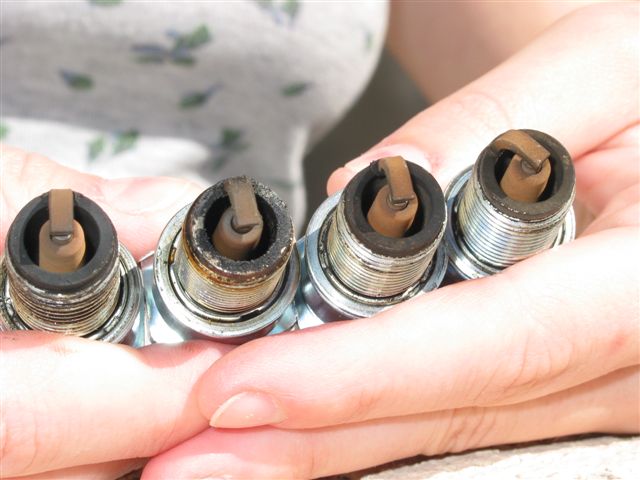 | ||
| Mike Procopio (Pupz308)
Member Username: Pupz308 Post Number: 322 Registered: 10-2002 |
I've pulled the front spark plugs, and was hoping for some thoughts about next steps with my misfire diagnosis. Reference threads: 1. "Need help with spark plug condition, photos attached" http://www.ferrarichat.com/discus/messages/112/235168.html?1051201752 2. "Running on less than 8 cyls, but still both banks?" http://www.ferrarichat.com/discus/messages/112/234941.html?1051067810 I had initially suspected that I was running on 7 cylinders for the following reaons: 1. The car felt slightly underpowered 2. My engine gas temperature readings were slightly down 3. My exhaust smelled worse than usual 4. The engine idled and just felt a bit rougher than usual I pulled the rear plugs, they all looked fine. I pulled the front plugs, and here's where I stand. All the plugs look good, except for the front bank, cylinder #3 (second cylinder in from the passsenger side on the front bank). This plug looked very different from the others (see pictures). The others look great--nice, light brown. This #3 plug, however, was a darker brown, smelled like gasoline, and in general had more "crud" on it than the other plugs. I'm thinking that this cylinder is the problem. As a side note, the plug from cylinder #4, although it looked OK, also smelled like gasoline. I checked the resistance on the front bank plug wires, everything seems OK. Here are the results: Cylinder 4 Resistance: 1573 Ohms Length: 26in Resistance/Length: 60.5 Ohms/inch Cylinder 3 Resistance: 1397 Ohms Length: 22in Resistance/Length: 63.5 Ohms/inch Cylinder 2 Resistance: 1058 Ohms Length: 18.5in Resistance/Length: 57 Ohms/inch Cylinder 1 Resistance: 681 Ohms Length: 15.5in Resistance/Length: 44 Ohms/inch All of the spark plug extenders had 0 or negligible (< .005ohms) resistance. I was hoping to have a bad plug wire, but that doesn't look like the problem. There is a correleation between this plug and a cylinder that was reading lower on a compression test. In September of 2002, I got the following results from a compression test: Cylinder 1 -- 135 Cylinder 2 -- 133 Cylinder 3 -- 129 Cylinder 4 -- 132 Cylinder 5 -- 133 Cylinder 6 -- 135 Cylinder 7 -- 132 Cylinder 8 -- 132 Cylinder 3 (the one with the bad plug) has the lowest compression reading. One final note. The #3 plug in question was MUCH more difficult to remove--I really didn't think I was going to be able to get it out of the cylinder. It required much more force to "loosen" it initially than than the other three plugs required. What do I do now? Is this when I throw in the towel and take it to my mechanic? Photos: 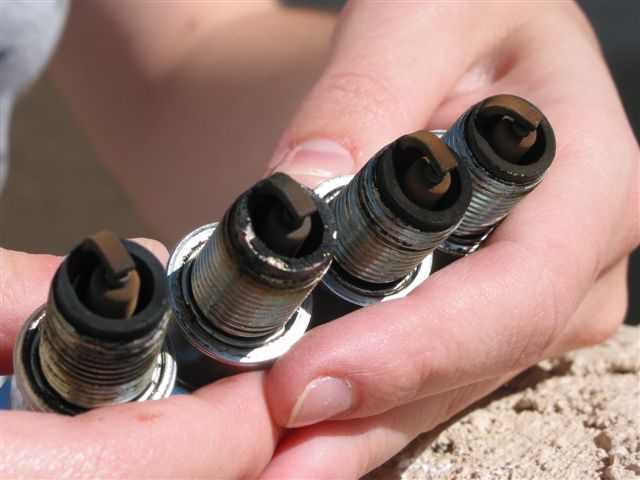  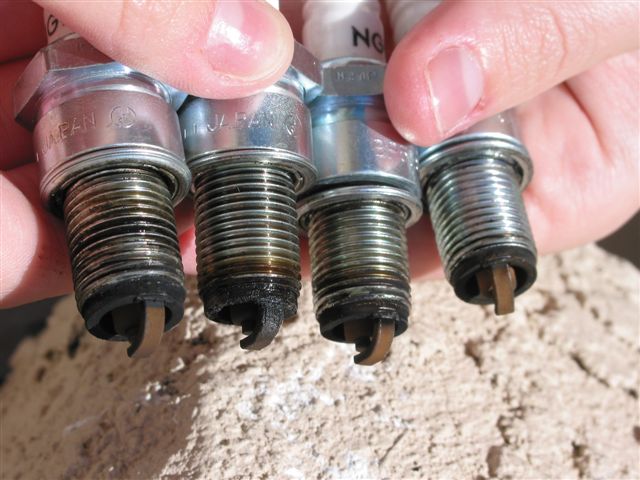 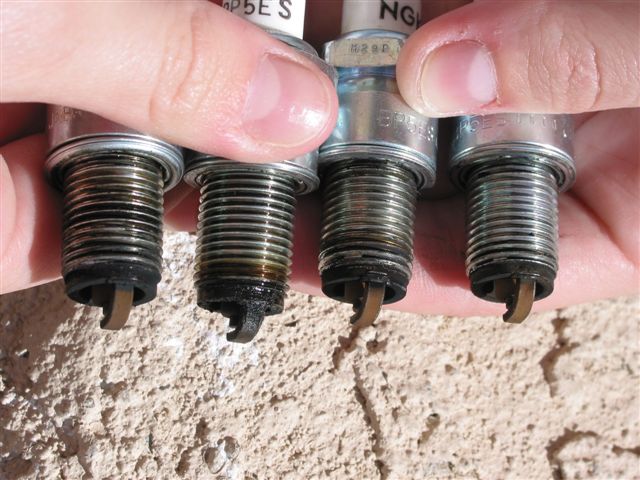 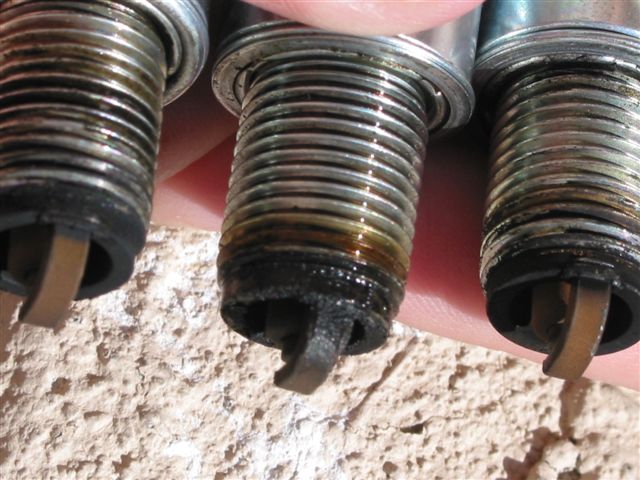 |